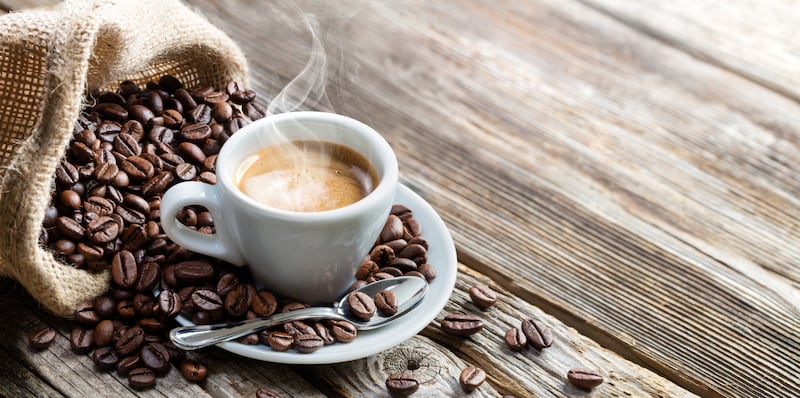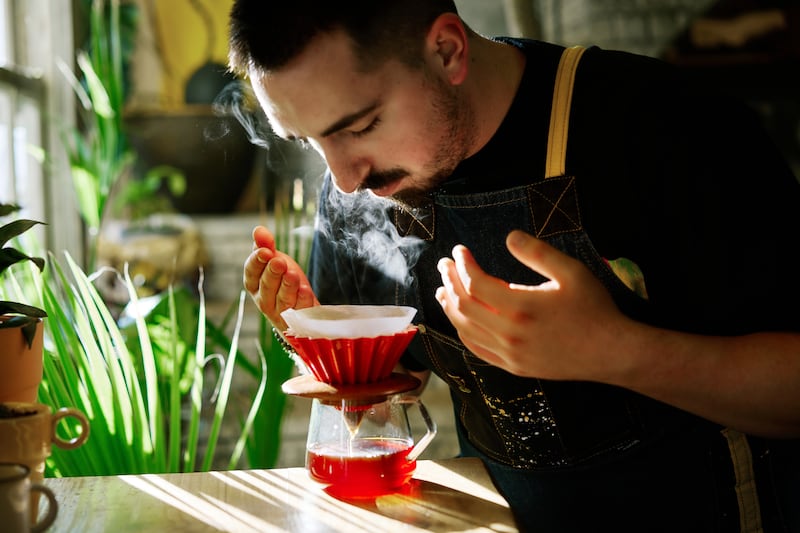Coffee. Go juice. Liquid gold. The one with all the psychoactive properties. Once used by Sufi mystics as an aid to concentration during religious rituals, it’s now one of the most ubiquitous drinks on the planet: we get through about 2bn cups a day.
It’s also one of the most valued and pored-over drinks. One particularly sought-after blend, Black Ivory, which is produced by encouraging elephants to digest arabica berries, retails at almost €2,000 a kilogram, while coffee-making championships attract thousands of spectators.
I see a lot of people who have three coffees more or less back to back in the morning. That’s not a sensible way to do things
— Nick Littlehales, sleep coach
But what does it actually do to you? You might have a vague idea that caffeine wakes you up, wrecks your sleep and can aid sporting performance, but do you know how much you can drink safely? Considering that a typical americano contains more than 100 biologically active ingredients other than caffeine, what do you know about the drug you are glugging two or three times a day? What is happening inside your body when you have a double espresso in the morning?
How quickly does it act?
The effects may start before you even take a sip. Just inhaling the scent of coffee can improve memory and stimulate alertness, according to a 2019 study of 80 18-to 22-year-olds. Another study, from 2018, found that subjects did better in tests of analytical reasoning after a whiff of the good stuff. That said, the researchers in the 2018 study suggested that the effect probably had a placebo element, with the expectation of improved performance proving at least partly responsible.
READ MORE
What about when you actually drink it? “There’s a chance that the use of any supplement will carry a placebo effect,” says Dr Mike T Nelson, a researcher and performance specialist who recently co-wrote the International Society of Sports Nutrition’s position on coffee. “Many researchers use randomised, double-blinded, placebo-controlled trials to try to ferret that out. And if you look at some of the higher-dose caffeine studies and when they have been compared with a placebo, we still see a performance-enhancing effect of caffeine.”
This is why the effects really kick in some time after you start drinking. While a 2008 study found that the effects of a cup of coffee can occur just 10 minutes after ingestion, it said peak caffeine concentration in the blood occurred after 45 minutes.
How does coffee wake you up?

Caffeine acts as a central nervous system stimulant – making you more alert and focused, but potentially also more irritable and anxious. It’s all to do with your body’s adenosine receptors, which help to regulate your heart rate, blood flow and sleep-wake cycles. When adenosine – an organic compound that occurs naturally in your body – binds to these receptors, it triggers physiological responses that lead to a decrease in cellular activity, often promoting drowsiness and sleep.
Caffeine can fool your nerve cells and bind to these instead, preventing adenosine from doing its thing. This promotes increased alertness, while also allowing the brain’s stimulating neurotransmitters (such as dopamine) to run wild. This makes it a mood-booster for many people, but can also lead to anxiety after high doses. While your body adapts to caffeine’s effects after a while, different people can have very different responses to the same amount of it.
Can it really boost athletic performance?
It certainly can. A 2020 study of amateur cyclists found that coffee improved performance by an average of 1.7%. This may not sound like much, but it’s a big deal for even moderately competitive athletes. An older British study reported a dose-related improvement in tests of reaction times, memory and visual-spatial reasoning among coffee drinkers.

Most of these performance benefits come from caffeine, which is why coffee isn’t always the best option. A recent analysis by the consumer group Which? found that a medium cappuccino at Costa contains 325mg of caffeine, while the Starbucks equivalent has just 66mg. Even more confusingly, a 2003 study found a wide range of caffeine concentrations (259mg to 564mg a serving) in the same drink obtained from the same outlet on six consecutive days. (The NHS doesn’t give an upper limit for daily caffeine intake unless you are pregnant, but the US Food and Drug Administration suggests that 400mg is fine.)
“Beans can make a difference – standard robusta beans are higher in caffeine than arabica beans, for example,” says Nelson. “But there are other factors – roasting actually breaks down caffeine, so in general darker roasts will have a lower caffeine content. But even when outlets try to control for beans, brewing method and so on, the variability in caffeine content is still quite high.
“This is why, for athletes, if you’re using it purely for performance-enhancing effects and you want to be very specific with it, I recommend taking caffeine in a pill form, because you can control your intake better.
“I’ve worked with some endurance athletes in the past who would just stop and get a normal coffee at any shop before the race – and a lot of times their performance might be a little bit different, probably because the caffeine amount wasn’t as tightly controlled.”
When should you stop drinking it?
This is hotly contested. Caffeine has a half-life of about six hours, which means that if you have your final espresso at 4pm, half of the caffeine is still in your system at 10pm, when you should be winding down for the night. Plenty of people subscribe to the idea of a caffeine curfew – stopping at 2pm or 3pm, for instance – but that doesn’t mean it’s open season in the morning.

“It should be a nice, balanced thing,” says Nick Littlehales, a sleep coach who has worked with several high-profile football teams. “I see a lot of people who have three coffees more or less back to back in the morning. They’re at 1,000-1,500mg before they get to lunchtime – then they stop their intake. That’s not a sensible way to do things: it’s about keeping it nice and level, with no big ups and downs. Keep track of when you have a little bit of a low-energy lull, then you can actually use your caffeine intake strategically, to help you out at key times.”
Is it good for you?
This is where those other biologically active compounds come in. It’s also where the science becomes less clear. A few people suggest that excess intake may be linked to increased cancer risk or heart problems, while others say a few cups a day is fine.
Darker roasts, as well as being lower in caffeine, tend to contain fewer antioxidants and lower levels of chlorogenic acid, a compound that can protect the body against inflammation and cell damage
It’s helpful to look at meta-analyses of many studies – or, even better, an “umbrella review”. One of the largest of these, which looked at more than 200 meta-analyses in 2017, said: “Coffee consumption seems generally safe within usual levels of intake, with summary estimates indicating the largest risk reduction for various health outcomes at three to four cups a day, and more likely to benefit health than harm.” Another from the same year found that coffee was associated with a probable decreased risk of several forms of cancer, alongside cardiovascular disease, Parkinson’s disease and type 2 diabetes.
What about coffee’s other long-term benefits? There is some evidence that its mood-elevating effects can be beneficial over the long term. In a 2016 meta-analysis of observational studies, caffeine consumption was found to decrease the risk of depression, while a Finnish study from 2010 found a similar result with coffee. In the Finnish study, the connection was weaker when other caffeinated drinks were consumed – suggesting that there is something in coffee specifically that can affect mood. One theory is that it’s the antioxidants, as these tend to correlate with reduced stress overall.
Coffee can also help with burning fat, but it’s most effective in conjunction with exercise. “In order to get rid of fat, you have to break it from the cell and then burn it,” says Nelson. “Caffeine has been shown to increase lipolysis, or the breaking part.” So, having a quick cup before your morning workout does more than just give you an energy boost.
What about the way you drink it?
Does how you drink it make a difference? In short: yes. Darker roasts, as well as being lower in caffeine, tend to contain fewer antioxidants and lower levels of chlorogenic acid, a compound that can protect the body against inflammation and cell damage. When you grind the beans doesn’t matter (unless you prefer that fresh-ground flavour), but how much you grind them probably does – a finer grind releases more polyphenols, giving fine-ground brews slightly more beneficial effects.

Coffee filtered through paper (in an Aeropress or a V60, say) may be healthier than coffee made with a metal filter (in a cafetière, for example) or no filter at all. A study published in 2020 that followed more than 500,000 healthy coffee drinkers for about two decades found that those who drank filtered coffee (as opposed to just boiling ground beans and drinking the water) had lower rates of arterial disease and death. The study’s authors concluded that the substances in coffee that can raise LDL cholesterol – the “bad” kind – can be removed using a filter; they said a cup of unfiltered coffee typically contains about 30 times the concentration of the lipid-raising substances compared with filtered coffee.
Filtering coffee through paper using a V60 or other pour-over cone is healthier than using a cafetière, research suggests. Photograph: GS Visuals/Getty Images/Image Source
The brewing temperature doesn’t matter that much; while some purists will claim that pouring boiled water directly on to your coffee grounds will “burn” the flavour, it seems to have little effect on the beneficial compounds inside.
[ Tasting times: Filtering out the best coffee makersOpens in new window ]
[ How to make perfect coffee at home without a machineOpens in new window ]
As for which of the dizzying array of options in most coffee shops is best, surprisingly little research has been done. “I’d expect having a dose of fat – milk – with your coffee would slightly slow the effect of the caffeine, just as eating food with it would,” says Nelson. A study from 2001 looked at giving people caffeine with carbohydrates and found no additional performance-enhancing effects from taking the two together.
Obviously, if you drink half a pint of milk and two sugars in your latte, it increases the calorie count; is there any way to mitigate that? With a sprinkle of cinnamon, perhaps? “It’s probably not going to have a huge effect on fat-burning,” says Nelson. “There are some studies showing that it may help with glucose metabolism if you give it in a pretty high dose – so if you’re looking at glycemic control, it may be helpful for that. But I wouldn’t count on a little dusting doing much good.”
As for “bulletproof” coffee – the now-trademarked staple of aspiring biohackers made with butter or coconut oil – evidence of its benefits is more scarce than the marketing might make you think. Yes, it can curb cravings and stop you feeling peckish in the midmorning lull – because it comes with a big scoop of calorific fat – but if you are using it to replace a breakfast like eggs and spinach, you may be cutting down on the nutrients you get first thing in the morning.
So, what is the prescription? Up to three cups a day is probably fine, filtered if possible, dark roasted if you are trying to cut down on caffeine, but light if you are trying to benefit from the other ingredients. Space them out in the morning and try to leave a decent gap after your last one before you go to bed. Oh, and if you want to try your hand at the Aeropress world coffee-making championships, give it a go – they let anyone in. – Guardian




















